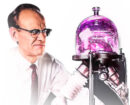The story of Mark Suppes' polywell fusion project in Brooklyn, NY continues to viralize itself around the virtual tubes of the Internetz. This morning CNN.com posted this story to its website:
New York (CNN) – Some people collect stamps or build miniature boats, while others obsess over their tricked-out cars — but what if your hobby was building a nuclear fusion reactor? For Mark Suppes, it is.
By day, Suppes is a freelance web developer at Gucci, but at night he works in a warehouse lab in Brooklyn, New York, experimenting with nuclear fusion..
This story strikes me as pretty well-rounded coverage, as it lacks the sensational "is it safe in my neighborhood??" angle of some of the earlier reports.
This one also quotes yours truly:
Paul Schatzkin, founder of Fusor.net, says people typically think of Hiroshima or the Chernobyl disaster when they hear the word nuclear."And when they hear it they should think sun," he says, "because what they are building is a miniature synthetic star. A fusion reaction is a star."
To which I can now add (because it didn't occur to me when I was talking to the reporter yesterday, that what all these fusion researchers are building amounts to "a star in a jar."
Which begs the obvious question, the conundrum that faces all fusion research: "How do you bottle a star?" In other words, how do you contain a reaction that is as hot as the sun without either destroying the container or extinguishing the reaction? I think that is the central challenge of the whole fusion experience. Whether or not it will ever produce useful industrial energy, that remains entirely debatable.
I am also pleased to read this remark from Stan Milora, the director of Fusion research at Oak Ridge Nat'l Laboratory:
Milora says that while Suppes' experiments may be amateur because they are smaller and less complex, they can be more efficient than the massive projects funded by national governments.
I think that's a point that we've stressed at Fusor.net from the very beginning: that, dollar for dollar, the results achieved in the basements and garages around the world by members of this site for thousands of dollars are equal in many respects to the results attained by large-scale, institutional and government-sponsored experiments costing millions, hundreds of millions, and now even multi-billions of dollars.
It is this notion that success can only become by throwing large sums of money at a problem that the work represented by this site fundamentally challenges.
If indeed fusion is ever to produce useful energy, I think the activity and discussion found here demonstrates that that "holy grail" as the press likes to call it is just as likely to be found at a grass-roots level than it will be found under a mountainous pile of cash.
But then, maybe the press is unwittingly right using such expressions as "Holy Grail." Last I read, other than fiction, we're still looking for that,
too.
